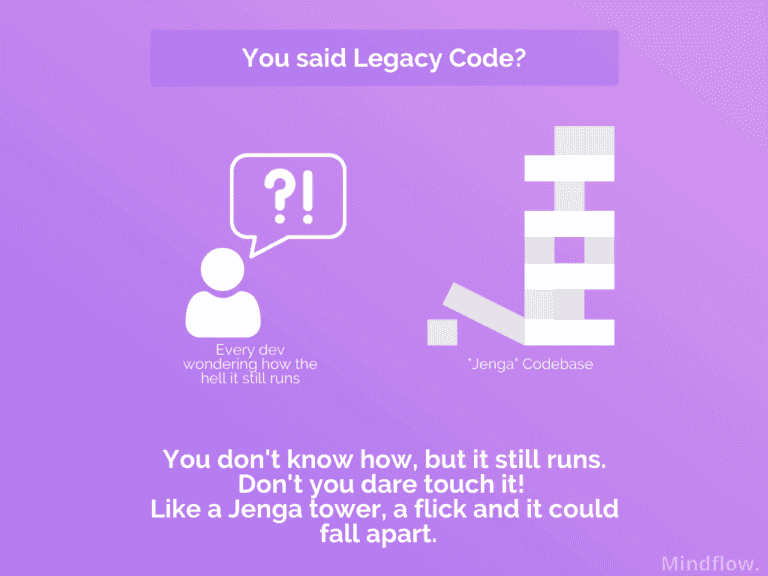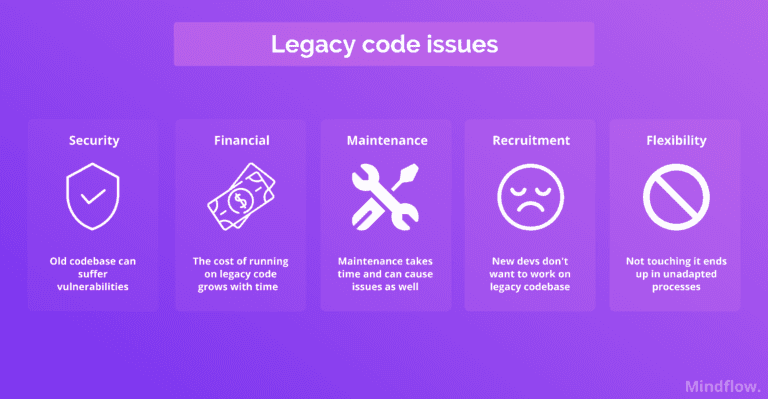Mar 8, 2022
Paul-Arthur
Jonville
As your company evolves, former employees go, new ones come, you adopt new technologies, and the broader tech environment evolves. Your processes need to follow these evolutions, too. If you start losing track of the curve, there is a risk of developing a debt over these technical aspects. Ultimately, this debt will cost you time, money, and security.
Thanks to their agility and freedom, no-code tools are increasingly seen as an answer to keeping companies ahead of the curve and fighting the lack of time, budget, and skills.
Relying on low-code or ancient tools aggravates technical debt by not solving one of its main factors, the legacy code. No-code tools precisely act on this significant obstacle to modern companies.
Below, we're going to read this:
Legacy code is everywhere
And it's increasingly difficult to deal with
It leads to lots of issues
No code tools are the best answer to reduce this technical debt
Legacy code is everywhere in your company
This situation can arise because this code has not been created with automated tests, or the lack of documentation makes it fragile to modify.
Developers usually distinguish 3 types of legacy code:
A code that its predecessors looked after. It's clear, commented, tested, and easily maintainable by successors.
Code is difficult to maintain. It's not easily understandable at first. There is dead or duplicated code, too large classes, few or no unit tests, etc.
An obsolete code that hasn't kept up with changes in the framework or language. Adding a feature is challenging, and developers spend time keeping the code afloat.
The legacy code isn't a failure in itself. Conversely, despite this growing technical debt, it proves that you've been successful. In any case, any code, no matter how perfect it can be at the time of its creation, will become a legacy at some point in the future. That's why it's essential to "refresh" the code and maintain it to avoid constituting or aggravating the technical debt.
However, companies also have to deal with a shortage of technical staff. Competition is rude in the developer market. It results in a high turnover, where developers change companies every few years. New developers are thus increasingly facing codes developed by others.
As time-to-market decreases to answer the demand, pressure to deliver code grows, and the final code sometimes lacks perfectibility, leaving the rest of the work to successors. Also, as time and workforce are needed, the time dedicated to maintaining or improving the code is reduced. Deliveries pile up over the initial code, tending to create this legacy code that is difficult to change.
This is why developers often talk about "code rot" or "spaghetti code" when referring to legacy code. This pictures the "get it done now" that is continually favored over "get it done right" ideally.
The challenge doesn't stop at developers. Over time, legacy code implies growing costs to your business. New software evolves, and older software is phased out. As time goes on, legacy code becomes more expensive as developers with the required skill sets become more challenging to find. This legacy code is often less efficient than modern code, further driving up costs. Finally, the legacy code could not even be compatible with modern solutions!
And it's increasingly difficult to deal with
As the technical debt grows because of the legacy code, there are various techniques to deal with it. You can retain it unless there are genuine reasons to change. The key to maintaining and managing a legacy code is to undertake a thorough discovery phase that helps identify potential challenges and dependencies on an obsolete platform. By the end of this phase, you can either rewrite the code or refactor it.
Rewriting legacy code requires a top-down approach. It is mainly chosen when the legacy code presents many issues, is poorly documented and without any earlier developers around, or requires the migration of architectural frameworks. Rewriting takes time, effort, and money and is thus considered the last option.
The other option is refactoring the code. This is a gradual approach where you update blocks by blocks, dead, or error lines of code to make the code easier to understand. People prefer this when there are known issues in certain parts of the code, and they know what needs to be changed. Following this technique also helps clean legacy code that is too complex, poorly written, or has too many errors with identified root causes.
However, companies often have to deal with such legacy code without the right skills, time, or money to handle it. These tasks are often pushed to the bottom of the to-do list, waiting for someone with enough will to take care of them.
Indeed, many developers don't want to do business with it. Refactoring legacy code may break functionalities without the right skill sets and proper due diligence, and new developers who are confronted with it are afraid to modify it.

Compare legacy code with a Jenga, for instance. Modifying a piece of the structure can lead to unexpected consequences, such as lack of equilibrium or total collapse. The same happens when modifying legacy code. Sometimes, it can generate unexpected malfunctions or even break the code. Moreover, over the years, the team has evolved.
The code becomes a real patchwork that is increasingly difficult to understand and modify until it becomes impossible to make updates or changes because no one understands the code and its effects anymore.
Consequently, even if you're technically indebted because of a legacy code issue, your devs don't want to touch it. If it works, they let it work because they risk breaking everything for not very much. There's no reason to change anything inside.
Long story short, devs don't want to touch your legacy code because doing so risks cutting a service that works.
Thus, it leads to lots of issues
Security
In 2017, Equifax, one of the world's largest credit rating agencies, suffered an attack from hackers who breached its systems and compromised the data of 148 million people. A report by the Government Accountability Office in the United States concluded that the breach was preventable and was partly caused by legacy code on the website that dated back to the 1970s!
Financial
Legacy code can cost a lot in maintenance and refactoring since it takes time. The more lines of code you have to maintain, the more technical debt you risk accumulating. An
by the CAST Research Labs of over 1400 apps and 550 million LOCs found that the average-sized application of 300,000 lines of code has over $1 million worth of technical debt.

Maintenance
The maintenance of code is rarely done by its author. Usually, new developers or less experienced ones are dedicated to it. However, a good chunk of the time is spent trying to understand the piece of code you're refactoring. Thus, code maintenance changes are commonly performed with an incomplete or partial understanding of the code. Consequently, nuances may be overlooked or mishandled because the code cannot be adequately understood within a limited time.
Also, once the code has been released, there is pressure to remedy problems quickly. Due to this limitation, many maintenance changes are not adequately planned or executed. Maintenance developers don't have time to research existing fixes for similar problems; thus, they only have partial visibility into the best practices. Each developer improvises its changes with little or no relevant information or comments about the code they're dealing with. Ultimately, changes will vary from developer to developer, sometimes in the same body of code, leading to a worse spaghetti code.
Recruitment
A code with high technical debt can scare hiring candidates, who are often looking for projects with modern, state-of-the-art technologies.
Flexibility
Often, people won't even try to modify the code because, as we said above, it would mean cutting a service that works. They sometimes keep unadapted or unoptimized workflows based on legacy code, although the environment has dramatically changed.
Embracing a no-code tool is the solution
No code tools let your company build robust custom solutions without writing a single line of code. These tools provide a layer of abstraction between your developers and the actual code. Therefore, they can focus on the logic rather than the proper code or syntax.
The platform providing you with the no-code tool handles the tech side. They take care of the technical aspects of your app. The actual code writing and the resources allocated to it are externalized to your solution provider. On your side, there's no need to maintain your code up-to-date since no code is created anymore. You won't have to deal with obsolete code. You can entirely focus on designing the logic and experience of the visual interface with configurable components.
Building solutions via a no-code tool is faster than coding from scratch. Eventually, you'll considerably reduce the risk of coding errors, although you'll also reduce the time to deploy your solutions and apps. Thus, you'll stay ahead of the curve and meet market demands. This acceleration hastens time-to-market and time-to-value for new solutions and any updates down the line.

Finally, a no-code tool helps mitigate the IT skills shortage. Modern programming languages take time and resources to learn and master, but no-code tools can be picked up in a matter of weeks. They lower the skill barrier needed to create.
As accessibility enablers, these no-code tools are precious assets for operating successful digital strategies in companies that often fail because of the lack of skills needed to deliver them.








